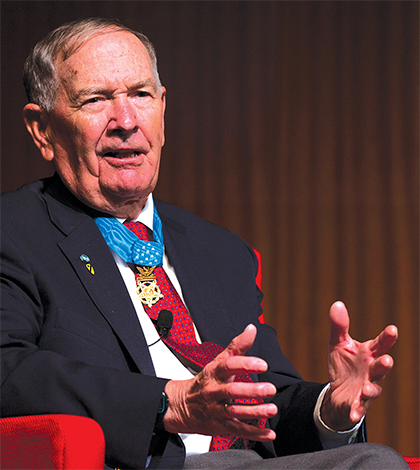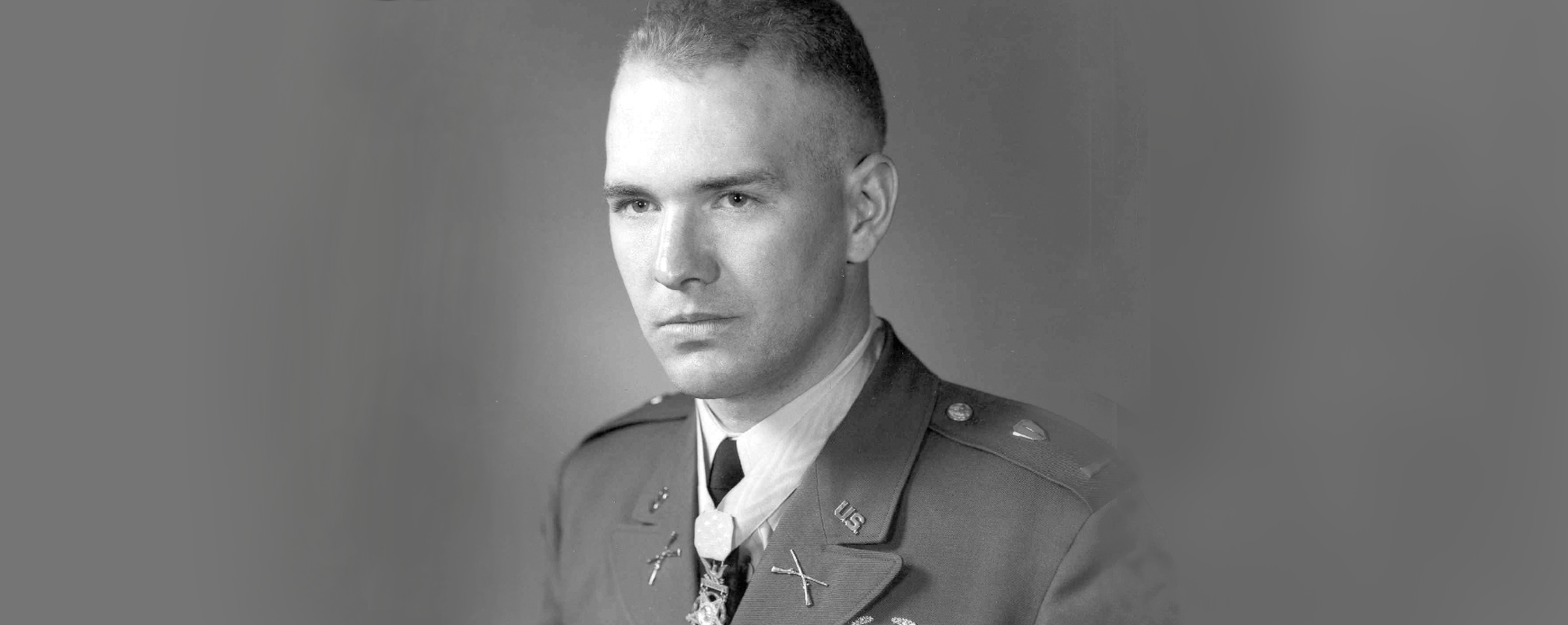Not Your Average Joe
Not Your Average Joe
Joe Marm is reticent to talk about himself and swiftly diverts the conversation to the bravery of his comrades. On all counts, he is a hero who endured the struggles and ravages of war. In his humility, he credits wearing his Miraculous Medal to surviving to tell his story.
 Joe Marm’s life began in Washington, Pennsylvania, a small town in the western part of the state that’s known as the home of the Whiskey Rebellion and P.O.N.Y. League baseball. His parents, Walter and Dorothy Marm, were devout Catholics who regularly attended Mass and sent their children to the local parochial school, which was where Marm learned about the Miraculous Medal and first began wearing one. Every evening in May, his family would kneel and pray along with a radio broadcast of the Rosary. In seventh grade, Marm became an altar boy; he laughs recounting how his “claim to fame” was being the first altar server to learn Latin. Not only did his family support him, but he and his father frequently rose early to attend morning Mass.
Joe Marm’s life began in Washington, Pennsylvania, a small town in the western part of the state that’s known as the home of the Whiskey Rebellion and P.O.N.Y. League baseball. His parents, Walter and Dorothy Marm, were devout Catholics who regularly attended Mass and sent their children to the local parochial school, which was where Marm learned about the Miraculous Medal and first began wearing one. Every evening in May, his family would kneel and pray along with a radio broadcast of the Rosary. In seventh grade, Marm became an altar boy; he laughs recounting how his “claim to fame” was being the first altar server to learn Latin. Not only did his family support him, but he and his father frequently rose early to attend morning Mass.
Fast forward to Duquesne University, where Marm was studying business. His future sergeant told him, “Marm, you’re gonna get drafted. Why don’t you enlist under the college option program and go to OCS (Officer Candidate School)?” That sounded like sound advice, so five days after graduating college, Marm began Basic Training, went to Advanced Individual Training, followed by six months of Infantry OCS (one of the toughest and most intense courses in the Army), and then Ranger School. While in Ranger School, his orders were changed to a unit at Fort Benning that was getting ready to deploy to Vietnam. Finally, in August 1965, Marm and 15,000 other soldiers (along with 400 helicopters) left for Vietnam. It took an entire month to get there.
When they arrived, they set up their base camp in the Central Highlands of South Vietnam. “When you think of Vietnam, you think of heavy jungle, but it was not like that in our area.” Marm explains. “It was elephant grass and trees and shrubs. A lot of our soldiers received upper body wounds in the chest or the head.”
Within three months, the first major battle—and one of the bloodiest—between the United States Army and the North Vietnamese Army erupted: the Battle of Ia Drang. The Americans were surrounded and outnumbered; the battlefield was heavy with dust and smoke; and the firepower against them “was so tremendous, it seemed impossible for anyone to survive.” The details of the battle are captured in the book, We Were Soldiers Once… and Young, as well as the 2002 movie, We Were Soldiers (Marm laughs as he explains that the title of the book was too long for a movie marquee, so they shortened it). “It was one of the better Vietnam movies,” he reflects. “They did an outstanding job with it. My name is not in the movie; they had to combine names and people.”
In the film, it was 2nd Lieutenant Jack Geoghegan who heroically charged the bunker. However, in reality, it wasMarm, a 2nd Lieutenant and platoon leader of A Company, 7th Cavalry Regiment (Airmobile). He was part of a two-company effort to rescue a platoon where “the entire chain of command was either killed or wounded,” Marm explains. These were Marm’s classmates, men he knew and respected. “So a young buck-sergeant named Erniep Savage took over.” Surrounded by enemy forces, Savage put “a ring of steel—artillery and mortar fire—around his position” to keep the rest of the platoon alive until they could be rescued.
“We made a two-company attack to try to get up there. But there was an enemy to our front, so we had a lot of resistance.” The “resistance” was using a well-concealed machine gun, and the attack on the companies was intense with soldiers “dropping all over the place.”2 Men were crawling through the elephant grass, amidst the smoke and commotion of combat, trying to dodge the machine-gun fire. To determine the precise location of the machine gun, Marm stood up, armed only with a rifle, to draw fire to himself. He saw that the attack was coming from behind a solidified rock anthill, about seven feet high, with trees and shrubs around it. He instructed one of his men to shoot an anti-tank weapon into the bunker, but with the humidity, it misfired. Marm grabbed it, rearmed it, stood up again, and fired. It worked, but it wasn’t enough.
“We were getting more fire, and I told one of my men—using sign language because of the battle noise—to go up there and throw a grenade over the top. He thought I meant to throw it from where we were, so he did.” It landed in front of the rock and went off but didn’t do any damage. “Rather than waste any time, I told my men to hold their fire (I didn’t want to get shot by my own men) and ran forward about thirty meters across open terrain. I got to the bunker, threw a grenade over the top, and ran to the left side, shooting some guys who were trying to shoot me.” At that moment, Marm was hit in the jaw. “The bullet went into my left jaw, pointed downward, and went out my right jaw. I never experienced that much pain before.”
That Marm survived is a miracle. That the bullet missed his jugular vein by an inch or so is another. But Marm was still wearing his Miraculous Medal from his parochial school days. And he can clearly echo the words of (St.) Pope John Paul II after being shot in 1981, “One hand pulled the trigger, another guided the bullet.” Mary unmistakably guided the bullet for Marm, too, who through his willingness to die for his men, saved their lives.
For his bravery and selfless actions, Marm received a military medal on December 19, 1966: the Congressional Medal of Honor. Part of the citation reads: “1st Lt. Marm’s selfless actions reduced the fire on his platoon, broke the enemy assault, and rallied his unit to continue toward the accomplishment of [their] mission. 1st Lt. Marm’s gallantry on the battlefield and his extraordinary intrepidity at the risk of his life are in the highest traditions of the U.S. Army and reflect great credit upon himself and the Armed Forces of his country.”
However, he doesn’t see the medal as a personal achievement; he believes he’s the custodian of something that commemorates the heroism of his fellow soldiers. “It’s a true honor to wear the medal, and to represent all the men I served with, because this medal belongs to them as much as it does me. There’s so much valor that goes on in combat and not all of it is recognized.” He then cites examples of that valor: his Company Commander, Captain Tony Nadal, who told the men, “Come on. There’s a platoon out there and we need to get them”—and was the first to lead the rescue mission. Or Ernie Savage, who had to take charge of the trapped platoon, and while being attacked and almost overtaken, kept the survivors safe. “He was just a young sergeant, but he took initiative, and they were able to survive.” Or Rick Rescola, who Marm describes as “a great soldier who was also very calm in combat” (his picture is on the book cover of We Were Soldiers Once). Decades later, as Director of Security for Morgan Stanley at the World Trade Center, Rescola successfully evacuated 2,687 employees on September 11. “Like a good soldier, he went back in to make sure the building was cleared,” Marm said. Then, the tower collapsed.
After receiving the Medal of Honor, Marm returned to Vietnam.
“I hated war,” he said, “but I thought I should pull my share of the hardship tours. My contemporaries who were staying in were going back for a second tour. Some of the helicopter pilots were doing a third tour because of the need for helicopter pilots. So I volunteered to go back.”
The Army won’t send a Medal of Honor recipient back into combat, so Marm had to sign a waiver declaring that he was choosing to place himself in harm’s way by returning to Vietnam. He remained in the Army until he retired as a Colonel in 1995.
Marm’s faith sustained him during his years in Vietnam. “When you’re sleeping outside every night, you look up into the stars, and you think about God and about what you’re doing there. There’s a lot of praying for everybody in combat. My closeness to Mary and to God helped me get through the tough times.” Marm also prayed the St. Michael Prayer frequently and can still recite it verbatim. “The rumor is,” he says smiling, “if you say that prayer for nine straight days, you won’t die in combat.”
His life is much calmer now, but he continues to pray the Hail Mary “for different people who have passed and for my relatives.” Not surprisingly, his parish church is St. Mary’s.
Reflecting on what it means to be a leader, Marm states, “If you wear a patch, it’s called ‘Follow Me.’ We lead by example; you don’t ask your men and women to do anything you wouldn’t do yourself. And that can be tough. Sometimes courageous.”
Of course, the example of “Follow Me” leadership par excellence is Jesus—and then our Blessed Mother. They have lead Marm throughout his life. Through Mary’s hands, Heaven’s graces were poured upon him: graces for his safety; for his willingness to return to combat for our country and the men fighting for it; and for his perseverance in faith through trials most of us can’t begin to fathom. And for all of that, he has medals of highest distinction: the Medal of Honor, which, Marm says with a smile, was first made in Philadelphia, and the Miraculous Medal, which was “made” in Heaven.
FOR HEROISM IN VIETNAM
Captain Joe Marm at age 27 gave up a desk job to return to head an airborne unit in Vietnam. He was the first of sixty-one Medal of Honor recipients to return to Vietnam after receiving the award.


